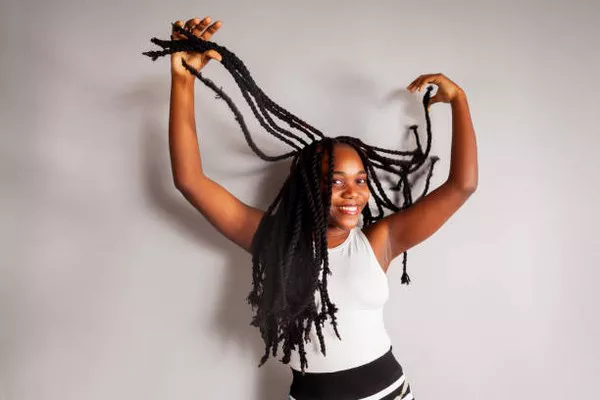As a Black woman, embracing braids is a cherished aspect of my identity. Braids allow me to express my style and simplify my hair routine for weeks at a time. With a diverse array of protective styles, including stitch cornrows, passion twists, and Fulani braids, changing my look becomes an enjoyable exploration. However, for some individuals, the beauty of these hairstyles can come with unexpected challenges that extend beyond financial costs.
If you’ve experienced itchiness or irritation soon after braiding your hair, the type of synthetic hair extensions you choose may be to blame. The most commonly used option is Kanekalon, a synthetic fiber treated with various chemicals, some of which have been associated with health risks, including cancer. While this hair is affordable, visually appealing, and convenient, it can provoke allergic reactions, scalp irritation, and even hair loss for some wearers.
Expert Opinions
To better understand the issues surrounding synthetic braiding hair, we consulted a panel of professionals:
- Cynthia Johnson, a Baltimore-based cosmetic chemist and founder of Cindy J Cosmetic Labs, LLC.
- Dr. Zoë Indigo Smith, a board-certified dermatologist based in Los Angeles.
- Brenda Johnson, a Chicago-based hairstylist.
What is Synthetic Braiding Hair Made Of?
Most synthetic braiding hair on the market is composed of acrylic or nylon fibers, coated with chemicals to mimic the texture of natural human hair. According to Cynthia Johnson, many brands apply silicone, a synthetic polymer, to enhance shine and reduce frizz.
Kanekalon, in particular, contains vinyl chloride—a chemical used to keep the hair soft and lightweight. Vinyl chloride is primarily known for its role in producing PVC materials and is classified as a carcinogen, especially dangerous for individuals frequently exposed to its fumes in manufacturing settings.
Dr. Smith warns that the lack of regulation in the hair industry means consumers are often unaware of the specific ingredients in their braiding hair. She emphasizes that chemical coatings can contribute to scalp irritation, especially when heated, which may release additional harmful compounds.
Potential Risks of Synthetic Hair
The primary concern associated with synthetic braiding hair is scalp irritation, which can lead to more serious complications. Dr. Smith explains that allergic reactions can cause inflammation, potentially resulting in hair loss. “Think of your hair like grass; if the soil isn’t right, it won’t thrive,” she says, likening inflammation to poor soil conditions affecting hair health. If untreated, irritation can lead to a form of alopecia.
There are also growing concerns about the potential cancer risks linked to the chemicals used in synthetic hair. Research indicates that toxic volatile organic compounds (VOCs) may be emitted when synthetic hair is heated above 250°C. While further studies are needed to fully understand these risks, both braiders and clients should be aware of the potential dangers.
Cleaning Synthetic Hair Before Use
One effective method to minimize scalp irritation is to cleanse synthetic hair prior to installation. Brenda Johnson recommends an apple cider vinegar (ACV) rinse—a mixture of two parts water to one part ACV—soaking the hair for up to an hour. This natural remedy is preferred over traditional shampoos because ACV neutralizes the high pH levels associated with chemical coatings, aligning better with the scalp’s natural acidity.
Johnson advises preparing the ACV bath a day or two before braiding to ensure the hair dries completely—this can take up to 24 hours. She cautions against using excessive vinegar, which could affect the hair’s quality.
Testing for Allergies
When selecting braiding hair, consider not only the price and convenience but also performing an allergy test. Dr. Smith suggests rubbing a small section of the hair against your skin, such as behind your ear or on your wrist, and observing for any reactions over the next 48 hours. Many products are not easily resealable, so check return policies before purchasing. Inquire whether the beauty supply store offers hair samples for testing.
Exploring Alternatives to Synthetic Hair
For individuals allergic to synthetic fibers or overwhelmed by the cleansing process, various alternatives are now available. Options include 100% human hair and plant-based hair extensions.
Brands like Rebundle and Lillian Augusta Beauty offer plant-based alternatives to Kanekalon. Dosso Beauty provides Kanekalon that has already been cleansed and infused with beneficial oils to help reduce irritation. However, it is crucial to conduct patch tests with all hair types, as natural products can still provoke allergic reactions.
Human hair extensions, sourced directly from donors, offer a higher-quality alternative but come at a higher cost, averaging $170-$200 for a pack. While they can be reused if cared for properly, they may require more maintenance compared to synthetic options, which are often pre-stretched and tangle-free.
Using human hair can also lead to frizz appearing sooner than expected. In contrast, synthetic hair typically maintains a neat appearance due to its chemical coating.
For those who prefer the look and ease of synthetic hair, styles like knotless braids—where the extensions are not tightly wound against the scalp—can help minimize irritation. In this method, the stylist begins braiding with natural hair before integrating the extensions, reducing direct contact with the scalp.
Conclusion
If scalp irritation persists, it may be related to the tension from the braids rather than the hair type itself. Regardless of the materials used, allowing your hair to “breathe” between styles is crucial. Avoid getting protective hairstyles back-to-back to ensure the health of your scalp and hair.
Related Topics:
How To Create A Full Head Of Braids For A Party
How To Easily Learn Retro Braiding At Home
How To Create A Classic High Braid


